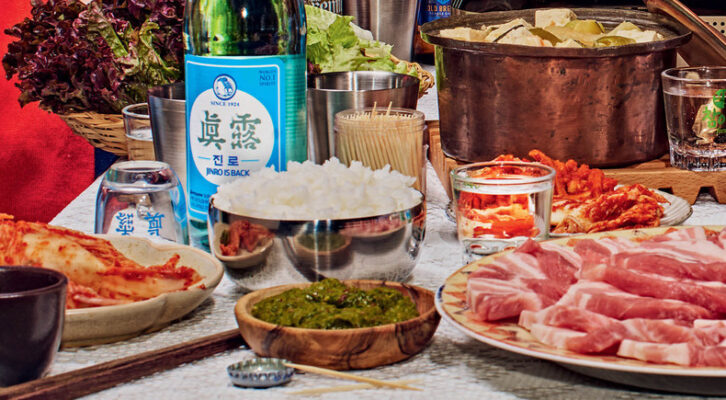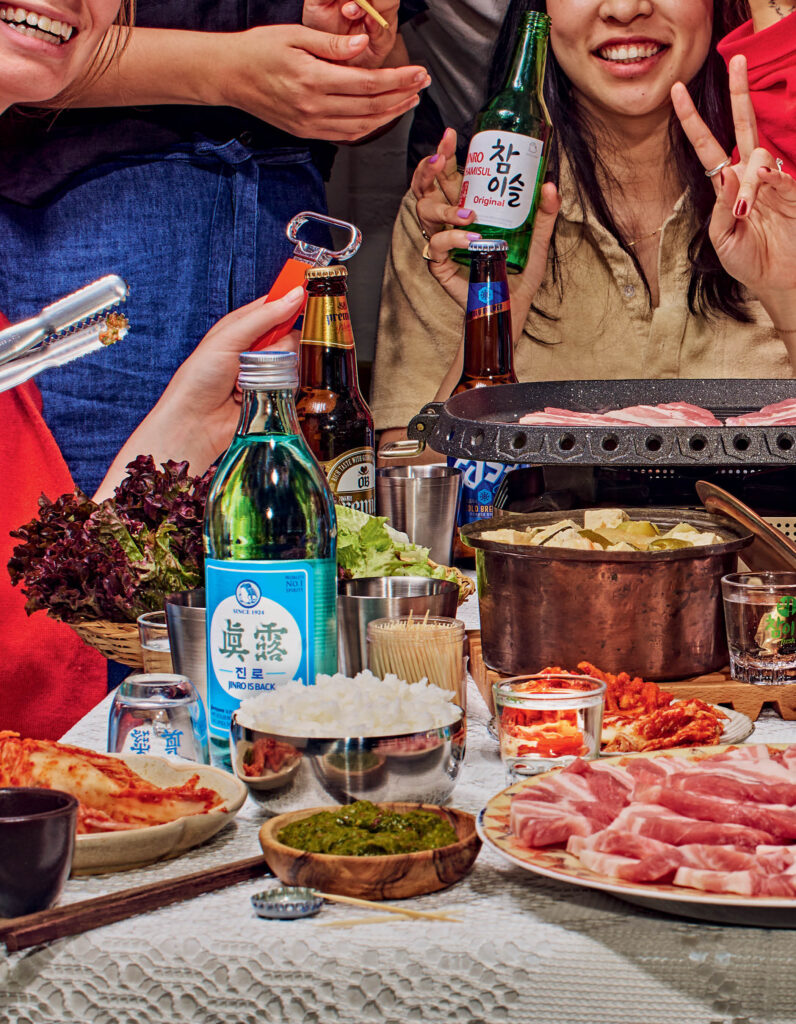
How to Party Like a Korean in the Middle of a Hurricane
Irene Yoo Help You Make Mouthwatering Korean Grilled Pork Belly (Perfect For Any Party)
When the city that never sleeps shuts down, its residents will find a way to keep the party going. Such was the case during Hurricane Irene, a tropical storm anticipated to be so destructive that the New York City mayor closed all businesses and transportation for the entirety of that sweaty August weekend. With nothing to do and nowhere to go, I decided to throw a “Hurricane Me” party at my apartment (the storm and I shared the same name) and invited the friends who could reach me on foot or by bike to hunker down and weather the storm together.
On the menu were my favorite things to eat and drink, a perfect opportunity to share my personal Korean American-style comfort foods. While we watched live news updates (the Weather Channel had never been so popular), I first rolled out kimchi-slaw fish tacos and beers, and then fired up my portable gas stove and threw shingles of frozen pork belly and beef brisket on top of a metal Korean BBQ plate.
Everyone gathered around to help flip the meat, stuffing wads of lettuce wraps into their cheeks and washing it down with soju. As the storm petered out and passed without much ado, I plonked down a Dutch oven of budae jjigae-style ddukbokki, which we forked into our mouths even as our eyes grew heavy with sleep.
A sool party is literally just a party with alcohol, but the best Korean sool parties are hosted at home like this—more of a never-ending friend hang than a packed blowout party. The goal is to share time together, catch up on life, and ultimately just bond over good food and drink. I like to plan mine around a fun interactive theme or dish: hosting a mini-kimjang where we make kimchi for people to take home and eat alongside freshly boiled bossam and shots of soju; a makgeolli tasting party comparing different brands from the supermarket; or Korean fried chicken from our favorite local takeout spot (hi, Peeps Kitchen!). But it doesn’t always need to be so elaborate—you can also just grab a couple bottles of your favorite booze and some snacks. If you’ve got good company, you’ve got yourself a sool party.
*
Some tips & ideas for hosting your own sool party:
Stock up on frozen Korean BBQ meats and accoutrements.
Plan for one bottle of soju per person (more if your group consists of heavy drinkers) and grab a case of beer and some sodas to supplement.
Create a captivating centerpiece to wow your guests, like a large-format punch served in a whole watermelon or a big pot of Budae Jjigae brimming with Spam morsels and bricks of ramyun noodles. This is definitely the time to try that viral dish or drink you saw online.
Or enlist your friends to bring an alcohol and an anju each, potluck-style (and take some of the pressure off yourself).
Course it out to keep the night going instead of serving everything all at once; it will prevent people from getting full and sleepy too soon.
Always keep a stash of instant ramyun or late-night snacks; you’re bound to get hungry again later.
When you run out of food and conversation, wind down the night by firing up the karaoke machine, dancing along to K-pop videos, or turning on an episode of the latest hot drama or a good movie.
*

Samgyeopsal
삼겹살
We can’t talk about drinking soju without talking samgyeopsal (pork belly), the ultimate pairing. I can smell it now: the smoky air hanging thick with porky grease, my eyes stinging a bit through the charcoal. Pork fat crackling as it hits the grill, glasses clinking and sloshing and slamming on the table, the din of tables chattering away broken by the occasional “Ajumma!” “Jeogiyo!”
Waiters flit by with watercolor-red curlicues of marbled pork, baskets stacked with lettuce leaves. The tables are covered edge to edge with banchan: bright pungent kimchi, bubbling soybean stews, maybe a little ice cream scoop of mac salad. I smell grilled pork and immediately start salivating for soju.
Korean BBQ has long been a mainstay of Korean food culture: a way for friends and family to gather and celebrate birthdays or job promotions, or just to have a good time. It’s a pretty straightforward concept: Cook razor-thin cuts or bite-sized pieces of meat tableside to minimize both cooking time and the distance from cooktop to plate—something that’s key for people who love to eat their food piping hot. The spread of banchan—side dishes that fill out a traditional Korean meal—that surrounds the central grill serves as a choose-your-own-adventure map for perfectly embellishing your meats of choice. This inherently communal nature makes the whole experience fun and low stakes, and therefore easy to set up at home.
What to prep:
You can cook samgyeopsal in a cast-iron or nonstick skillet, or any similar griddle, on your stovetop. Or upgrade your tableside setup with a portable camp stove and butane cans. Fire it up with a Korean-style grill pan—its special grooves keep the meat from sticking and help drain grease. It’s also worth sourcing Korean BBQ tongs—I love them not only for grilling but for cooking in general.
What to buy:
Most Asian grocery stores will have everything you need: short- or medium-grain white rice, fresh red-leaf lettuce and perilla leaves (my personal favorite!), and premade banchan.
The Pork Belly
Korean BBQ at home is made easy by the availability of presliced meats at Asian grocery stores. Pork belly comes in two options: thinly sliced or thickly sliced. The thinly sliced pork belly is shaved into curlicues and cooks up super quickly and crisply, so it’s great for an impatient group or as a first round. Thick slices are more akin to what you’d find at Korean BBQ restaurants nowadays; they’ll cook and sizzle in their own fat as you sip your soju and gab with your table, resulting in juicy, unctuous bites.
When picking your pork belly, look for good marbling: where the white fat is distributed beautifully through the pink-red muscle. The more white speckles the better, and a few striations or strips of white are good, but I would avoid pieces that are a lot more than half fat or feature stringy, tough-looking streaks of fat.
Pork belly will classically have three or five stripes of fat—you’ll want these to be tightly layered with the stripes of meat.
Plan for one-quarter to one-half pound of meat per person, adjusting for people’s appetites and the amount of other dishes you plan to have to fill out the table. A smaller portion can go a long way when wrapped with spoonfuls of rice in filling lettuce wraps, but leftover meat can easily be thrown into stews or ramyun as a round two.
Sides & sauces
This is where the fun begins! The rich, meaty samgyeopsal holds up well to bold flavors, seasonings, and textures like:
Pa-muchim 파무침—shaved scallion salad
Buchu-muchim 부추무침— seasoned garlic chives
Saengchae 무생채— spicy or sweet-and-sour radish salad
Ssamjang 쌈장— a salty, savory paste made with doenjang, gochujang, garlic, sesame oil, and other aromatics, used for dipping meats and making ssam (wraps)
Kimchi
Raw garlic cloves
Red- or green-leaf lettuce or perilla leaves, washed and dried
Rice
Doenjang jjigae or kimchi jjigae
How to cook:
Once your table is ready, heat up your grill on the burner—use a small piece of fat to oil the grill, or a paper towel lightly soaked in vegetable or sesame oil.
Keep sliced meat frozen until cook time—you can take it out 5 to 10 minutes beforehand to help separate the pieces. Lay out each piece on the grill so they don’t overlap, and cook on one side until the edges start to curl. Flip and cook until your desired doneness (floppy or extra crispy). Since it’s your BBQ, it’s your call!
Build your ssam:
As the cooked meats get plucked off the grill, prepare your lettuce wrap in one hand (you can rip large leaves in half ) and place the meat in the leaf’s center. Dollop on a bit of ssamjang and whatever other accoutrements float your boat, like a spoonful of rice to fill out your bite, some pa-muchim to add crunch and acid, or any banchan or kimchi. Then just fold the leaf over your stack and pop the whole thing into your mouth!
Repeat and repeat until your heart is content and your belly is full.
__________________________________

From Soju Party How to Drink (and Eat!) Like a Korean: A Cookbook by Irene Yoo. Copyright © 2025 by Irene Yoo. Excerpted by permission of Alfred A. Knopf, a division of Penguin Random House LLC. All rights reserved. No part of this excerpt may be reproduced or reprinted without permission in writing from the publisher.
Irene Yoo
Irene Yoo is a food writer, recipe developer, creator (Yooeating), YouTube cohost (KA KA Studio), and the chef and co-owner of Orion Bar in Brooklyn. Raised in Los Angeles and Seoul, she graduated from the University of Pennsylvania and previously worked as a photo and video producer for Food Network. Her recipes and essays have appeared on foodnetwork.com, on Food52, and in Food & Wine, and she has spoken about Korean culinary history at the Korea Society and the Museum of Food and Drink (MOFAD). She has been featured in The New York Times, The Korea Times, and Bon Appétit.



















